Inside: 12 tips on how to learn Spanish and become fluent in Spanish outside of the classroom.
Welcome back to Lorena & Lennox, Bilingual Beginnings! If you’re new here, a warm welcome to you as well. I’m excited to have recently shifted my focus to bilingual parenting, Spanish education, and multicultural living, and I’m thrilled to share this journey with you.
While I’m not a native Spanish speaker, my passion for the language has been a driving force in my life for over 15 years. With a background in Spanish translation and Latin American studies, I’ve dedicated myself to mastering Spanish and fostering bilingualism in my son and future children.
Despite my formal education in Spanish, most of my language learning journey has taken place outside the classroom. Today, I’m excited to share with you some of the language learning tips and strategies that have proven invaluable to me along the way.
Whether you’re interested in learning Spanish or any other language, I’m confident that these tips will be incredibly useful to you on your language learning journey.
I invite you to enjoy this post and share your thoughts or any additional language learning tips you may have in the comments below. Let’s embark on this exciting linguistic adventure together!
*This site may contain affiliate links. To real the full disclosure, click here.
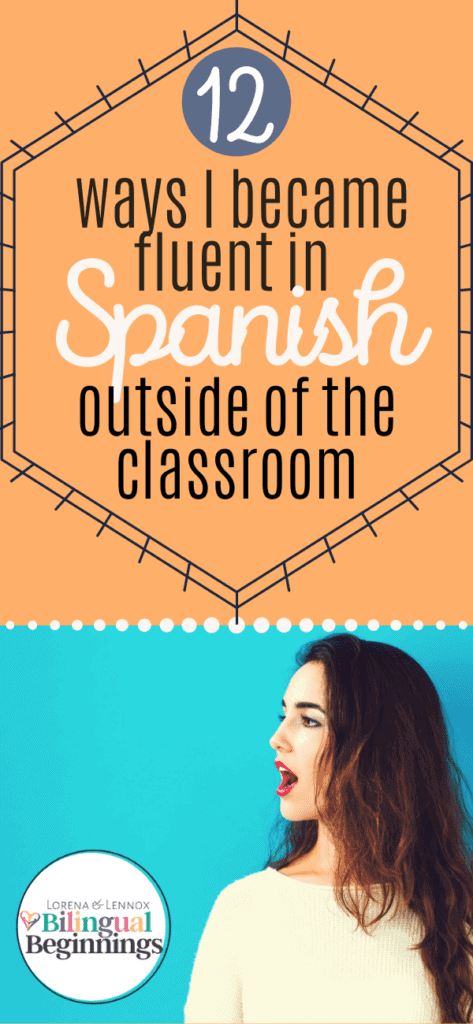
12 Tips on How to Learn Spanish Outside of the Classroom
1. Traveling
Travel is the driving force behind learning a language.
My first time traveling was to Nicaragua on a mission trip with my church when I was 15 years old. My parents were not very happy with my decision to go. They kept reminding me how dangerous the country was, and they were, for sure, something terrible would happen to me. That didn’t scare me.
I had already taken a couple high school Spanish classes, and I was curious to test out my knowledge.
I was there for a total of two weeks and let me tell you this, I hardly understand any Spanish.
Nicaraguans speak so fast, with such a heavy accent that I might have understood one out of every ten words.
The communication barrier made me so frustrated, especially when we traveled to a tiny community in northern Nicaragua, called La Danta.
The lifestyle contrasted so much to mine. There was no running water, no flooring or walls. No nearby stores. The kids had to walk two miles or more to get to school. Chickens were running around freely. People slept in hammocks. Bathrooms consisted of latrines 30 or 40 ft from the house, and bathing consisted of buckets of water or going to the river. Lastly, there was zero technology.
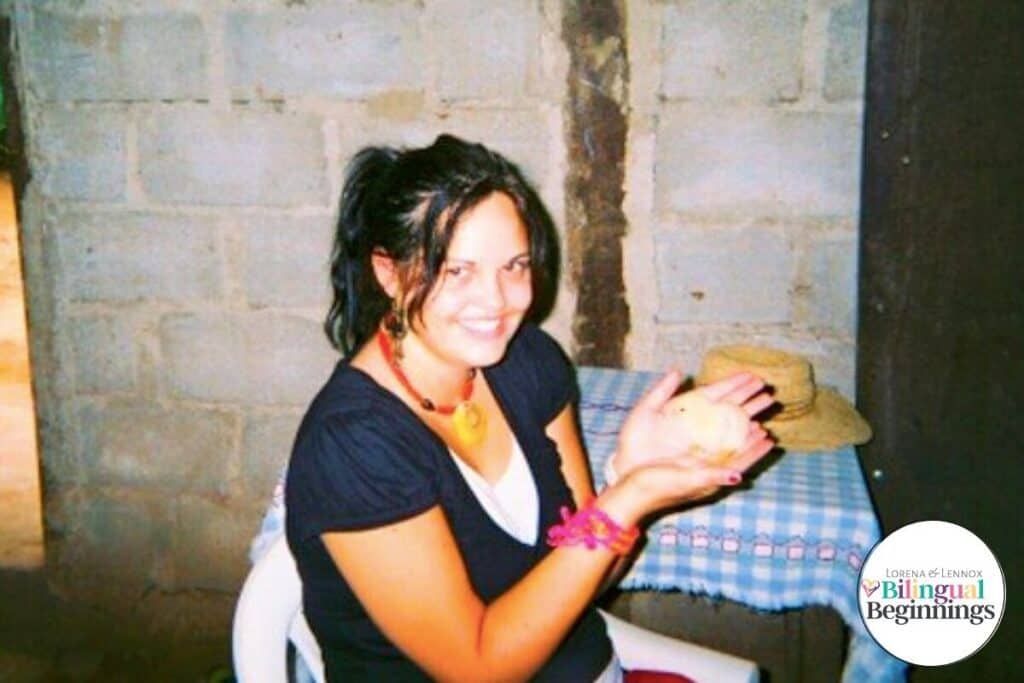
I was in shock, yet I felt more peaceful than I ever had in my entire life.
And the people were so kind and humble. They always had a huge smile on their face. When I tried to speak Spanish to them, they were so grateful. This touched my heart.
I wanted to be able to communicate with these people and know more about them, but my lack of conversational Spanish did not allow me to establish a deeper connection.

This first trip changed the rest of my life forever.
I traveled two more times to Nicaragua in the following two years. Each time I was more determined to communicate with Nicaragua’s people and let me tell you, by my last trip, I was having full blown conversations.
Going back to the point of this post, traveling in itself did not help me learn Spanish. However, it was the driving force to my burning desire to learn the language. Exposure to the culture and dialects helped me understand that Spanish isn’t merely a word to word translation of English.
This goes for all languages. Every language has its own structure, sense of time, and cultural significance, so to possess real knowledge of a language, you have to understand its culture.
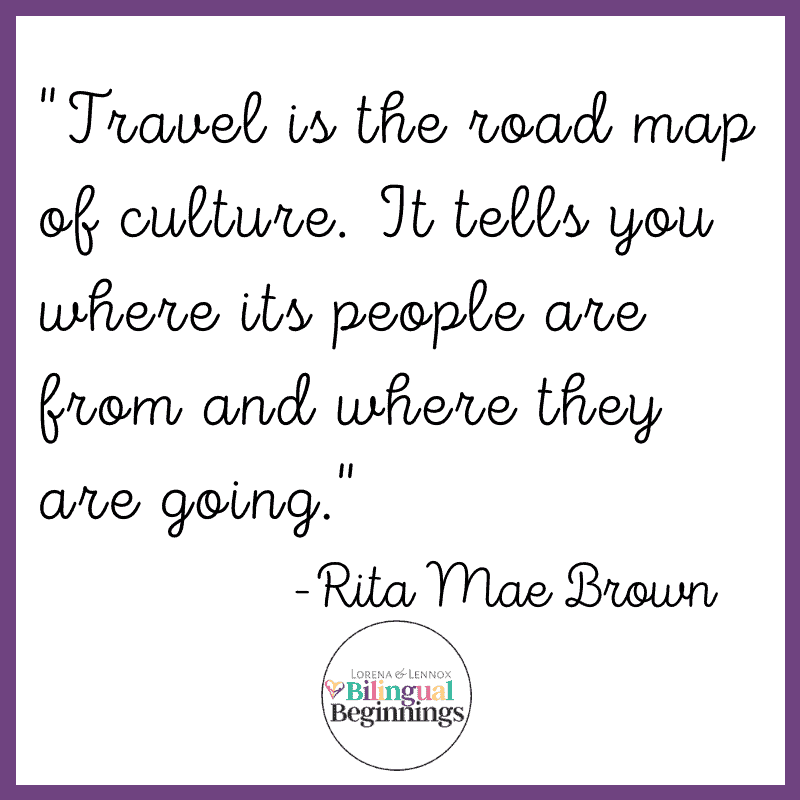
2.Making Friends
Traveling will open your soul to learning a new language, its people, and its culture. However, it shouldn’t stop there.
It is incredibly beneficial to make friends who speak your target language where you live as well.
As soon as I returned from Nicaragua, I was hungry to meet new people. I grew up in a relatively rural area where there were very few minorities.
One day, two new Latino brothers arrived at my high school. I watched them for a few days at lunchtime, itching to get to know them. Each day, they sat at a table by themselves, and I saw many of my peers glare and giggle in their direction. It made me so very angry, so I decided to sit with them.
I initially spoke to them in English. They felt so uncomfortable. Their body gestures showed it all. However, once I started talking to them with my limited Spanish knowledge, they relaxed, and I could see a sense of relief.
From that day on, I sat with them every day at lunch, and together we helped each other learn our target languages. By the end of the year, I had learned so much Spanish from them. In return, their English had improved drastically.
I am forever grateful for their friendship. They inspired me to step out of my comfort zone.
My friendships with Latinos and people of diverse cultures only grew from there. I found people that spoke Spanish in every area of my life, work, school, extracurricular activities, and I would immediately introduce myself in Spanish.
I have learned a majority of my Spanish through them and met my life partner this way.
3. Music
Music is a fun, portable, catchy, self-study resource. By listening to it, you can improve your pronunciation, enrich your vocabulary, increase memorization, and learn new phrases.
Music is one of the best tools for learning a language.
Music is a fun, portable, catchy, self-study resource. By listening to it, you can improve your pronunciation, enrich your vocabulary, increase memorization, and learn new phrases.
Latin American music is so eclectic. There are so many different genres, bachata, merengue, reggaetón, salsa, vallenato, regional Mexican music, and more.
Get out there are learn about these different genres and find some songs that you love. Once you find a song you cannot stop singing, proceed to tip four.
Related: The Ultimate List of Christmas Songs in Spanish: Spice Up Your Holiday Playlist Esta Navidad
4. Translating Songs
The notebook featured below was my everything throughout my last year of high school. I had already taken all of the Spanish classes possible, so instead of choosing an elective, I decided to do an independent study Spanish class.

I had 1 hour and 45 minutes every other day to do whatever I wanted to do to learn Spanish, and I did not slack off.
Most of my remaining tips took place inside this notebook, so buckle up and take notes. It’s time to learn Spanish.
Now, I consider these activities as “outside of the classroom” activities. Even though some of the pictures have edits from the teacher who “supervised” my independent study, I did these activities in all of my spare time. That’s just how passionate I was about Spanish, and I hope you feel this passion too.
Throughout this notebook, you can find lots of pieces of paper taped inside. These are song lyrics. Since I had started listening to Latino music, there were a handful of songs that were so catchy, I knew all of the words to them, but I did not fully understand their meaning.
I used this to my advantage.
I would print out a hard copy of the lyrics, read through them, and circle words and phrases that I did not know. On the side of the paper, I would write them all down.
Then, I would look them up in a physical dictionary and write down all of the word’s usage. I would find the context of the word and plug its meaning into the song.
Now having a full understanding of all of the words in the lyrics, I would translate the entire song word for word.
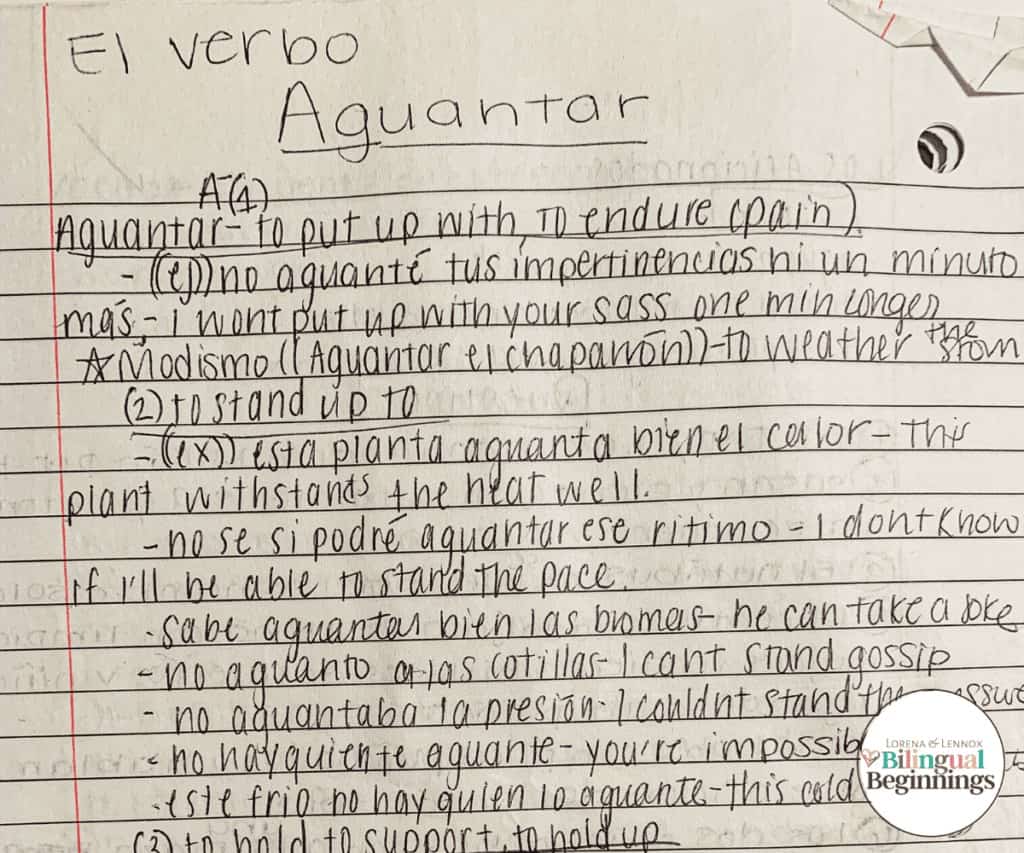
(Don’t judge my translations, these are from 2007. As a professional translator now, these are mortifying!!)
Lastly, I would obsessively listen to the song over and over again, nailing the pronunciation and fulling comprehending the meaning of the song. It was a beautiful and fun learning experience.
5. Verb Conjugations
In this notebook, I also kept a running list of new verbs that I came across in songs or other activities.
In all of my spare time, especially in all of my other classes that were of no interest to me, I would conjugate each verb in every tense: present, imperfect, preterite, present subjunctive, past subjunctive, future, conditional, and the gerund.

I enjoy doodling. It helps me listen, so conjugating these verbs was quite fun for me. It was even more fun when I came across an irregular verb!
Conjugating verbs is great for practice and memorization of each tense and its usage.
6. Random Dictionary Dives
During my senior graduation, I won the Hispanic Language Excellence Award. As a gift, the head of the Spanish department gave me a hardback copy of the 5th edition Collins Spanish Dictionary. I have never been so excited to receive a dictionary in my life.
Once a week, I used to go through my dictionary and randomly open to one of its 1285 pages and select a word. I would choose 20 words a week, and their corresponding page numbers. I made sure to circle or star the chosen words to mark my progress.
If the words were nouns, I would write down all of their meanings. Then, I would create a sample sentence to make sense of each definition. Creating sentences and reading them would help me memorize my new vocabulary.
To make sure my sentences were coherent, I would ask some of my friends if my sentences made any sense. Often, my friends wouldn’t understand a word because it wasn’t a word they frequently used in their dialect.
Next, I would refer back to the dictionary, and it would tell me where the word is mostly used, be in Spain, or different parts of Latin America.
With the selected verbs, I would do my conjugations that I talked about in the previous tip.
Diving through the dictionary was instrumental in building my vocabulary. I learned a ton of new words that I didn’t encounter in daily conversations or my education.
7. Read, and then read some more
Reading is so beneficial for language learning.
I remember profoundly disliking reading materials in my Spanish classes. However, once I started choosing reading material on my own, it became a fun way of learning the language.
Janina Klimas, from Fluent in 3 Months in her post Learn a Language by Reading: 5 Easy-to-Follow Steps, states the following:
“By learning to read in the language you’re studying, you get so much more out of the learning experience. When you come across words in several different contexts through reading, you start to understand and comprehend vocabulary in a more meaningful way. You can learn much more about language and culture than you could ever discover by reading a language-learning book through reading material written in that language.”
Today, I have a whole library of books in Spanish. Some of them were easy reads and others not so easy. However, I used the not-so-easy reads to my advantage by highlighting phrases that I did not understand, and underlining words that I did not know.”
When I came to a phrase or expression that I did not understand, I would break the sentence down and research it online. There are so many forums that are so helpful when you are stuck with an idiom.
Some of my favorite sites are www.Wordreference.com, www.Linguee.com, and www.ProZ.com.
As for unfamiliar words, I would try to understand the context of the paragraph and hypothesize the word’s meaning. After each chapter, I would write down all of the unknown terms and look them up in my dictionary.
I don’t know about you, but for me, writing things down with a pen on paper makes the words stick all the more.
If you are beginning to learn Spanish, I recommend reading children’s books. I offer thematic-lists of picture books in Spanish you can can choose from here.
8. Subtitles
Subtitles are another great resource. Even if you are watching a program in Spanish, put up some subtitles. By merely listening, you might not pick up on everything said, but reading subtitles can help focus you in on new expressions and vocabulary.
Keep a pen and paper with you, and jot them down!
9. Be Bold
Whenever you are out and about and hear someone speaking Spanish, say hello.
If you encounter a situation where someone needs help because they don’t speak English, help them.
One of my biggest things, and I am still trying to work on this because I get shy, is to speak in Spanish first. Especially when I go to my favorite place ever, Qdoba, where the majority of the chefs are Spanish-speaking, I talk to them in Spanish first.
Their faces change entirely, and they are so thrilled to have someone speak to them in their native tongue.
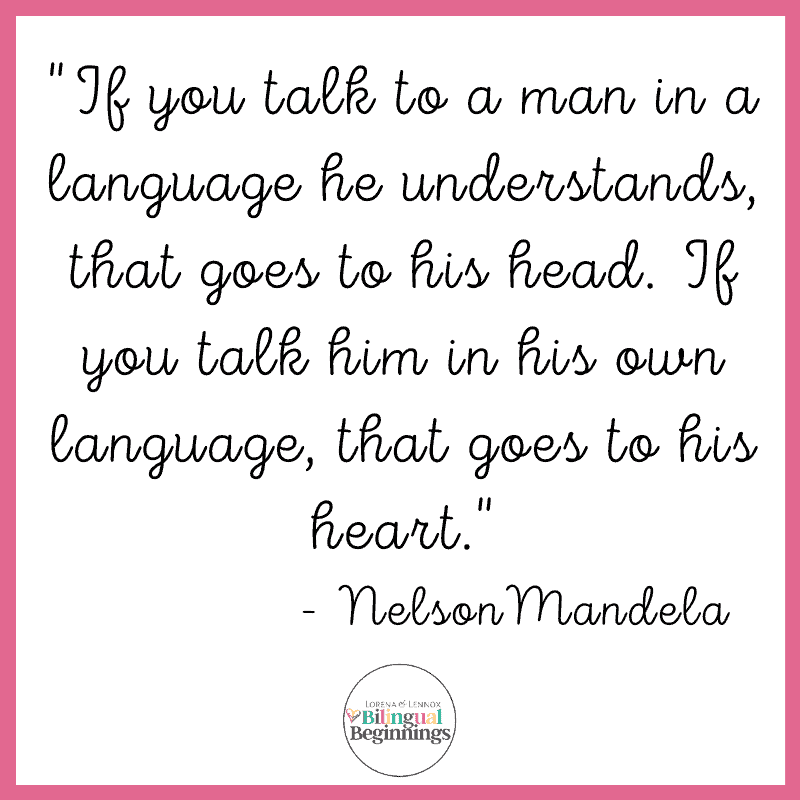
Not only will you get some heartwarming reactions, but you can experience new dialects and culture.
I am always intrigued to talk to people with dialects diverse from what I am used to hearing. I could listen to them talk all day and hear their phonetic nuances and cultural expressions. It’s fascinating.
I have rarely received a negative response from talking to new people in Spanish, no matter what my level of language was at the time. What I have experienced is a Spanish-speaking person who prefers to speak to me in English. When that happens I follow their lead, maybe they want their practice too.
10. Be Curious
Being curious about a language will instill a passion for learning it. All of my tips will only work if you are curious.
Curiosity of the world will ignite you to travel. Travel will make you curious about the culture and history of a country. Culture and history will make you curious about the language.
Devour every Spanish word spoken your way, and when you come across something that you don’t understand, be curious enough to open your dictionary or consult with Dr. Google.
I know there have been a few words in the past that have just really stumped me—for example, aguantar. I never understood it’s meaning, but heard it so frequently in conversation.
After writing down everything I could find on the word, I finally started grasping its understanding.
Doing this, will define your language skills and broaden your understanding of how language learning works.
11. Storytelling
One of my favorite things upon meeting someone new is to listen to their history and life stories. It will help you understand their identity and culture.
When you meet someone new, ask them about themselves.
12. Cultural Learning
Last but not least, language and culture are so intricately related, it is important to learn about culture as well. Histories, food, music, dances and more will all contribute to a better understanding of the language you are trying to learn.
Related post: Step By Step Salvadoran Pescado Frito
There are so many documentaries and literature that I could recommend to learn about Spanish and Latin American culture but I will save them for a future post =)
Well, I hope you enjoyed these 12 outside of the classroom Spanish language learning tips. I have plenty of more ideas for future posts that I know will guide you in your language acquisition. Stay tuned =)
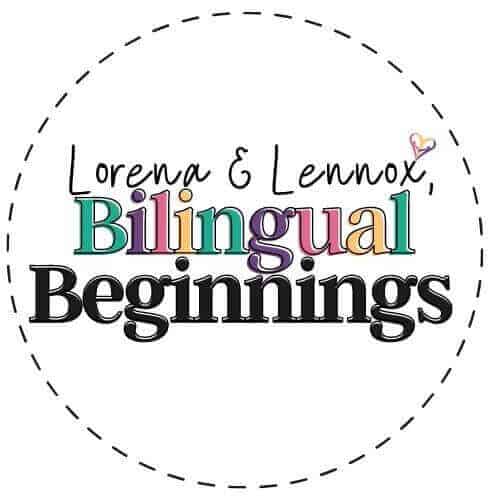
kalkan.villas
Monday 3rd of October 2022
For the reason that the admin of this site is working, no uncertainty very quickly it will be renowned, due to its quality contents.
María
Thursday 27th of August 2020
I am a a Spanish teacher from Nicaragua, and I am so glad you liked the country so much that you returned! Thanks!
Lorena Ruprecht
Wednesday 25th of November 2020
María,
I adore your country and cannot wait to take my son there when he is older!
Thank you for reading and commenting on my blog!
Lorena
Jessica Collazo
Friday 28th of February 2020
As a Spanish native speaker I am so fascinated when people try to learn my language... Spanish is a difficult language to learn it had different nouns different times and is very descriptive and romantic. Qué bueno que estás haciendo el esfuerzo de aprender español.